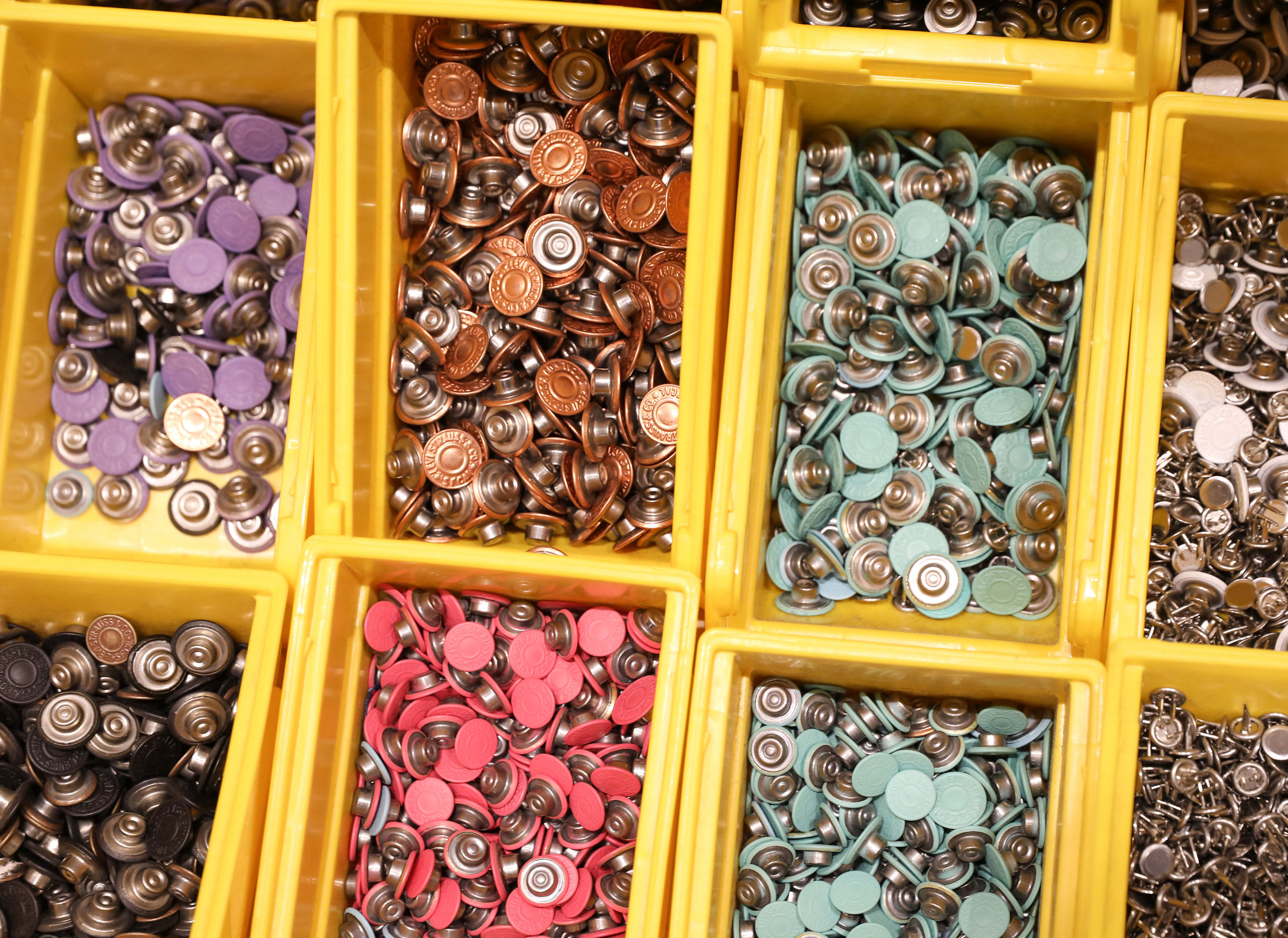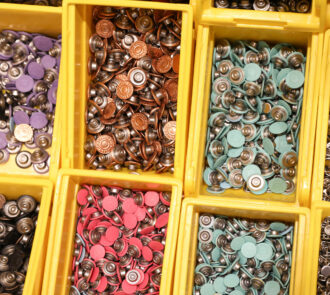
Our Performance: Data Tables
An Overview of Our Key Performance Indicators
Climate
Climate Action
| Metrics | FY20 | FY21 |
|---|---|---|
| GHG emissions associated with our company-owned facilities | 21,338 mtCO2e | 16,956 mtCO2e |
| Percent reduction in Scope 1 and 2 emissions from 2016 base year | 57.3% | 66% |
| Emissions from energy combusted onsite (Scope 1) | 8,967 mtCO2e | 10,703 mtCO2e |
| Emissions from purchased energy (Scope 2) | 12,373 mtCO2e | 6,253 mtCO2e |
| GHG Emissions Intensity (Scopes 1 and 2) | N/A | 2.94 mtCO2e per $1 million of net revenue |
| Metric | FY20 | FY21 |
|---|---|---|
| Scope 3 Category 1 Emissions: Purchased Goods and Services | 2,344,071 mtCO2e (60.4%) | 2,129,301 mtCO2e (54.3%) |
| Scope 3 Category 2 Emissions: Capital Goods | 8,816 mtCO2e (0.2%) | 9,307 mtCO2e (0.2%) |
| Scope 3 Category 3 Emissions: Fuel-and-energy-related activities | 9,720 mtCO2e (0.3%) | 8,399 mtCO2e (0.2%) |
| Scope 3 Category 4 Emissions: Upstream transportation and distribution** | 63,302 mtCO2e (1.6%) | 94,863 mtCO2e (2.4%) |
| Scope 3 Category 5 Emissions: Waste generated in operations** | 11,046 mtCO2e (0.3%) | 13,836 mtCO2e (0.4%) |
| Scope 3 Category 6 Emissions: Business travel | 4,842 mtCO2e (0.1%) | 1,907 mtCO2e (<.1%) |
| Scope 3 Category 7 Emissions: Employee commuting | 5,758 mtCO2e (0.2%) | 6,173 mtCO2e (0.2%) |
| Scope 3 Category 9 Emissions: Downstream transportation and distribution** | 242,831 mtCO2e (6.3%) | 283,404 mtCO2e (7.2%) |
| Scope 3 Category 11 Emissions: Use of sold products** | 1,077,673 mtCO2e (27.8%) | 1,229,576 mtCO2e (31.4%) |
| Scope 3 Category 12 Emissions: End-of-life treatment of sold products | 65,530 mtCO2e (1.7%) | 89,673 mtCO2e (2.3%) |
| Scope 3 Category 14 Emissions: Franchises** | 25,028 mtCO2e (0.6%) | 36,732 mtCO2e (0.9%) |
| Total Scope 3 Emissions | 3,879,957 mtCO2e | 3,903,171 mtCO2e |
Metric
Scope 3 Category 1 Emissions: Purchased Goods and Services
FY20
2,344,071 mtCO2e (60.4%)
FY21
2,129,301 mtCO2e (54.3%)
Metric
Scope 3 Category 2 Emissions: Capital Goods
FY20
8,816 mtCO2e (0.2%)
FY21
9,307 mtCO2e (0.2%)
Metric
Scope 3 Category 3 Emissions: Fuel-and-energy-related activities
FY20
9,720 mtCO2e (0.3%)
FY21
8,399 mtCO2e (0.2%)
Metric
Scope 3 Category 4 Emissions: Upstream transportation and distribution**
FY20
63,302 mtCO2e (1.6%)
FY21
94,863 mtCO2e (2.4%)
Metric
Scope 3 Category 5 Emissions: Waste generated in operations**
FY20
11,046 mtCO2e (0.3%)
FY21
13,836 mtCO2e (0.4%)
Metric
Scope 3 Category 6 Emissions: Business travel
FY20
4,842 mtCO2e (0.1%)
FY21
1,907 mtCO2e (<.1%)
Metric
Scope 3 Category 7 Emissions: Employee commuting
FY20
5,758 mtCO2e (0.2%)
FY21
6,173 mtCO2e (0.2%)
Metric
Scope 3 Category 9 Emissions: Downstream transportation and distribution**
FY20
242,831 mtCO2e (6.3%)
FY21
283,404 mtCO2e (7.2%)
Metric
Scope 3 Category 11 Emissions: Use of sold products**
FY20
1,077,673 mtCO2e (27.8%)
FY21
1,229,576 mtCO2e (31.4%)
Metric
Scope 3 Category 12 Emissions: End-of-life treatment of sold products
FY20
65,530 mtCO2e (1.7%)
FY21
89,673 mtCO2e (2.3%)
| Metric | FY20 | FY21 |
|---|---|---|
| Electricity (percent of energy footprint) | 71.4% | 67.5% |
| Natural Gas (percent of energy footprint) | 25.7% | 26.8% |
| Other (percent of energy footprint) | 2.9% | 5.7% |
| Percent renewable electricity in all company-owned facilities | 76% 82,221 MWh renewable electricity |
84.8%**** 88,706 MWh renewable electricity |
| Total energy consumption | 151,337 MWh | 154,960 MWh |
| Reporting Category | Percentage of Footprint |
|---|---|
| Direct emissions from sources owned and controlled by LS&Co. | 0.3% |
| Purchased electricity, steam, heat and cooling | 0.2% |
| Purchased goods and services | 54.3% |
| Capital goods | 0.2% |
| Fuel-and-energy-related activities | 0.2% |
| Upstream transportation and distribution* | 2.4% |
| Waste generated in operations* | 0.4% |
| Business travel | <0.1% |
| Employee commuting | 0.2% |
| Downstream transportation and distribution* | 7.2% |
| Use of sold products* | 31.4% |
| End of life treatment of sold products | 2.3% |
| Franchises* | 0.9% |
| Reporting Category | Percentage of Footprint |
|---|---|
| Fabric production (includes weaving) | 40.2% |
| Yarn production (includes spinning) | 31.7% |
| Raw materials | 13.3% |
| Garment assembly | 7.4% |
| Indirect sourcing | 7.3% |
| Material Type | % of Total Product Mix* | % of Raw Material Carbon Footprint |
|---|---|---|
| Cotton | 89% | 77% |
| Polyester | 5% | 11% |
| Manmade cellulosics | 4% | 8% |
| Elastane | 1% | 3% |
| Other (wool, leather, hemp, etc.) | <1% | 1% |
For more information, visit Climate Action.
Water Stewardship
| Target | Metric | FY20 | FY21 |
|---|---|---|---|
| Reduce freshwater use in the manufacturing of our products by 50% in areas of high water stress by 2025 (against a 2018 base year) | Percent reduction of manufacturing water use in areas of high water stress | 22% reduction in water use | Will be available following verification of Higg FEM data |
| 100% of key fabric and garment suppliers will meet their new contextual Water<Less® targets (key suppliers cover approximately 80% of our annual product volume) by 2025 | Percentage of key fabric and garment suppliers meeting Water<Less® targets due to designation as Reduce & Recycle facilities | 16% | 14% |
| N/A | Liters of recycled water used in the manufacturing of LS&Co. products | 3,510,094,240 liters | 2,988,420,053 liters |
Target
Reduce freshwater use in the manufacturing of our products by 50% in areas of high water stress by 2025 (against a 2018 base year)
Metric
Percent reduction of manufacturing water use in areas of high water stress
FY20
22% reduction in water use
FY21
Will be available following verification of Higg FEM data
Target
100% of key fabric and garment suppliers will meet their new contextual Water<Less® targets (key suppliers cover approximately 80% of our annual product volume) by 2025
Metric
Percentage of key fabric and garment suppliers meeting Water<Less® targets due to designation as Reduce & Recycle facilities
FY20
16%
FY21
14%
For more information, visit Water Stewardship.
Consumption
Sustainable Fibers
| Type of Fiber | FY21 Percentage Used in Our Products |
|---|---|
| Cotton that is organic, recycled or Better Cotton | 95% of all cotton |
| Manmade cellulosic fibers sourced from Canopy Green Shirt-rated suppliers | 100% of all manmade cellulosic fibers |
| Down sourced from Responsible Down Standard-certified suppliers | 100% of all down |
| Leather sourced from Leather Working Group (LWG)-rated suppliers | >35% of all leather |
| Recycled polyester | 8% of all polyester |
Type of Fiber
Cotton that is organic, recycled or Better Cotton
FY21 Percentage Used in Our Products
95% of all cotton
Type of Fiber
Manmade cellulosic fibers sourced from Canopy Green Shirt-rated suppliers
FY21 Percentage Used in Our Products
100% of all manmade cellulosic fibers
Type of Fiber
Down sourced from Responsible Down Standard-certified suppliers
FY21 Percentage Used in Our Products
100% of all down
| Type of Fiber | FY21 |
|---|---|
| Cotton (Better Cotton) | 67% |
| Cotton (conventional) | 18% |
| Cotton (organic) | 4% |
| Polyester | 5% |
| Manmade cellulosics | 4% |
| Elastane | 1% |
| Other (wool, leather, hemp, etc.) | <1% |
For more information, visit Sustainable Fibers.
Safer Chemicals
| Safer Chemicals | FY21 |
|---|---|
| Number of chemicals on the LS&Co. Preferred Chemical List, which encourages our suppliers to use safer alternatives in their manufacturing | ~1,300 |
| Number of factories using LS&Co.’s Preferred Chemical List and reporting chemical use to the CleanChain tool | ~100 |
| Pass rate of suppliers in Restricted Substances List testing | 99.94% |
| Pass rate of suppliers in random product testing (at 80% of Tier 1 factories) | 100% |
Safer Chemicals
Number of chemicals on the LS&Co. Preferred Chemical List, which encourages our suppliers to use safer alternatives in their manufacturing
FY21
~1,300
For more information, visit Safer Chemicals.
Community
Diversity, Equity and Inclusion
| Metric | 2021 |
|---|---|
| Executive Leadership Team | 61.5% women; 38.5% men |
| Top Management** | 42.6% women; 57.4% men |
| Corporate Employees | 55.4% women; 44.6% men |
| Frontline Workers | 58.2% women; 41.8% men |
| Metric | 2021 |
|---|---|
| Executive Leadership Team | 84.6% White 7.7%: Asian 7.7% Latinx |
| Top Management** | 64.9% White 15.7% Asian 9.4% Latinx 4.7% Black 2.1% Other BIPOC*** 3.2% no data |
| Corporate Employees | 50.7% White 23.3% Asian 11.5% Latinx 7.3% Black 4.5% Other BIPOC 2.7% no data |
| Frontline Workers | 31.1% White 36.8% Latinx 20.5% Black 5.2% Other BIPOC 5.3% Asian 1.1% no data |
| Metric | 2021 |
|---|---|
| Number of workshops and learning sessions offered | 75 |
| Number of active global learners across our corporate and retail populations | 12,926 |
| Number of translated languages for training | 20+ |
| Global completion rate achieved | 87% |
| Metric | 2021 |
|---|---|
| Number of formalized partnerships with organizations working to develop diverse talent pipelines in areas most relevant to LS&Co. | 13 |
| Number of established partnership programs | 10 |
| Number of hosted branding and recruiting events | 12 |
| Number of converted diverse applicants | 1,578 |
| Number of strategic partnerships of our key business functions: Design and Brand, Technology and our Digital Enterprise | 3 |
For more data, visit the 2021 DE&I Impact Report.
Employee Health and Safety
| Metric | 2020* | 2021* | Industry Average (U.S. Bureau of Labor Statistics) |
|---|---|---|---|
| Total Recordable Incident Rate (TRIR)** at distribution centers | 3.54 | 2.52 | 4.80 |
| Incidents resulting in Days Away / Restricted Time (DART)** at distribution centers | 2.43 | 1.88 | 3.90 |
| Percent decrease in U.S. retail store worker’s comp claims between 2019-2021 | N/A | 36% | N/A |
Metric
Total Recordable Incident Rate (TRIR)** at distribution centers
2020*
3.54
2021*
2.52
Industry Average (U.S. Bureau of Labor Statistics)
4.80
For more information, visit Employee Health and Safety.
LS&Co. Employee Support Development
| Metric | FY21 |
|---|---|
| Number of employees | ~16,600 |
| Number of employees per country/location | 7,700 Americas 4,600 in Europe 4,300 in Asia |
| Number of employees in manufacturing and procurement | 1,600 |
| Number of employees in retail, including seasonal employees | 8,700 |
| Number of employees in distribution | 1,500 |
| Number of employees in non-production roles | 4,800 |
| New hires (global corporate)* | 900+ new hires in FY21 53.4% women 59.6% BIPOC (U.S.) |
| Percent employees participating in July 2021 employee engagement survey | 63% |
| Employee engagement score | 79% |
For more information, visit Employee Support and Development.
Supply Chain
| 2020 | 2021 | |
|---|---|---|
| Factory | 484 | 439 |
| Mill | 75 | 65 |
| Total | 559 | 504 |
| Tier | # facilities assessed - 2020 | Total # facilities - 2020 | % facilities assessed - 2020 | # facilities assessed - 2021 | Total # facilities - 2021 | % facilities assessed - 2021 |
|---|---|---|---|---|---|---|
| Tier 1 | 449 | 484 | 93% | 430 | 439 | 98% |
| Tier 2 | 70 | 75 | 93% | 65 | 65 | 100% |
| Direct Supplier or Licensee | # facilities assessed - 2020 | Total # facilities - 2020 | % facilities assessed - 2020 | # facilities assessed - 2021 | Total # facilities - 2021 | % facilities assessed - 2021 |
|---|---|---|---|---|---|---|
| Direct | 255 | 282 | 90% | 253 | 262 | 97% |
| Licensee | 194 | 202 | 96% | 177 | 177 | 100% |
| Tier | # of facilities assessed | # of facilities assessed against Code of Conduct | # of facilities assessed against Better Work | # of facilities assessed against Better Work | # of facilities assessed against SLCP |
|---|---|---|---|---|---|
| Tier 1 | 430 | 325 (76%) | 48 (11%) | 48 (11%) | 57 (13%) |
| Tier 2 | 65 | 40 (62%) | 0 | 0 | 25 (38%) |
| Issues | 2020 Completion | 2021 Completion |
|---|---|---|
| Environment | 89% | 85% |
| Health and Safety | 61% | 79% |
| Wages and Benefits | 71% | 61% |
| Legal Permits | 94% | 62% |
| Working Hours | 68% | 32% |
For more information, visit Supply Chain.
Philanthropy
| Metric | 2021 |
|---|---|
| Value of Levi Strauss Foundation grants | $9.5 million |
| Value of LS&Co. Direct Corporate grants* | $3.1 million |
| Value of LS&Co. product donations | $0.9 million in LS&Co. product donations** |
| Value of Red Tab Foundation grants | $2.2 million in cash grants*** |
| Number of Red Tab Foundation grants | 1,880 grants |
For more information, visit Using Our Platform.
Governance
Economic Contributions
| Metric | FY20 | FY21 |
|---|---|---|
| Net revenue | $4.5 billion | $5.8 billion |
| One-year change in net revenue | -23% | +29% |
| Net revenues from our global digital footprint* | 23% | 22% |
| Capital returned to shareholders** | $120 million | ~$200 million |
| Number of employees | ~14,800 | ~16,600 |
| Number of retail locations where our products are sold*** | ~50,000 | ~50,000 |
| Number of brand-dedicated stores and shop-in-shops | ~3,100 | ~3,100 |
| Number of new company-operated stores, net of closures | 137**** | 41 |
| Number of workers in our supply chain***** | ~457,000 | ~509,000 |
For more information, visit Governance.










